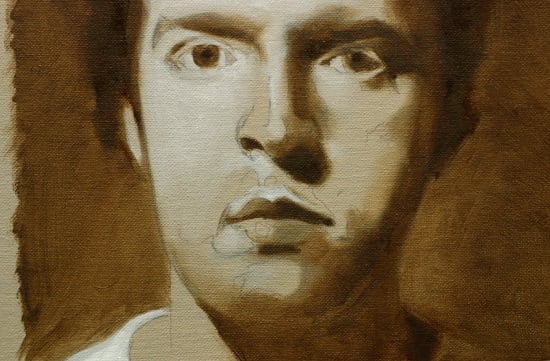
“When you come back to your painting you’ll notice how the oil has become translucent overnight and won’t have the same coverage that you first thought.”
How to paint a portrait series. This is part 3 of a 5 part series of tutorials for beginners making the transition from drawing to oil painting.
Here is a quick review of what we have covered so far if you’d like to join in…
Part 1 – Establishing the drawing, including the shadow line.
This can be done in pencil or charcoal (that you can fix with fixative) try to keep the drawing lines angular to start with.
Try to establish the basic shapes if you could only use a straight line, then add the contours as the drawing progresses. A classic beginner mistake when drawing a portrait is an over exaggeration of the curves in the face. Everything gets ’rounded off’ and the portrait can have a cartoon like quality. Because we have a strong visual memory system that tells us ‘faces are round’ this can subconsciously affect your drawing.
We the started to scrub in the underpainting layer. To a beginner, this stage is often skipped, deemed to be unimportant, but a good foundation is key to success with portraits.
We then have our 3 part tonal underpainting which allows you, and your eye, to become more in-tune with the image, and become aware to the tones.
Part 2 – Developing the tones, adding lights.
We then worked over the top of the initial underpainting still just with the raw umber to strengthen the tones and get a better feeling of form. These layers are all painted thinly.
The medium for this stage being a simple mix of 1 part linseed oil to 4 parts mineral spirits (artist turpentine or odourless mineral spirits) this establishes the ‘fat over lean’ rule. With each progressive layer being slightly fatter – with more oil content.
We also added some roughed in lights with a faster drying white.
This is to help us judge the tones for the next stage so when we paint them on they don’t look to ‘out’ when we add the lights.
The Allure of highlights
I forgot to emphasize at the end of part 2 that the roughed in lights are the light tonal mass and not the highlights.
The highlights and the very darkest parts of the painting should be the last brushstrokes to be done, but they try and draw you in! It’s hard to resist putting them on at the early stage.
And even if you’ve read the warning, it’s amazing how, when you get engrossed in the painting, your hand will be drawn to that lightest white.
This can seem counterintuitive if you are coming to the painting from drawing as we often erase out the lightest areas, or work on this area that attract our attention. The white highlights on the eye have a particular allure.
When the painting is finished these will be seen by the viewer to be painted with the most skill, however, a single dot of white can be painted by anyone, but resisting adding them takes the practice of an artist.
A note about grey
One of the students following this series let me know about Gambiln Torrit grey competition (Thanks Mario!) Every spring, the paint manufacture collect all of the residue paint pigment that have been collected by the air filtration system and recycle them into “Gamblin Torrit Grey”. You can learn more about the Torrit Grey painting competition from Gamblin website.
“Pigment dust should not go into the earth, water or landfill, but into paint,”
Robert Gamblin.
For our grey, we are going to mix a neutral using the raw umber and Ivory black.
Part 3 – First Painting & mixing a new medium

We now create a new medium for the next layer of the painting. Different artists vary the richness of the medium depending on their own personal preference but the next mix is a very useful one.
- 3 parts mineral spirit to 1 part linseed oil
You can use the pipette to measure out amounts, or if I’m mixing a larger amount I’ll use kitchen measurement spoons.
Pro tip: If you are doing a lot of painting it can be worth premixing a larger amount of each medium in resealable jars, label them up and then you can simply decant the medium each stage of the painting.
Mixing our black
We are now going to mix a neutral black for developing this monotone study. You can still create some lovely studies just using the raw umber and white, it is a warmer finish than the black, but you will still learn the importance of contrast in your paintings.

To mix the neutral, we use 3/4 ivory black to 1/4 raw umber. This helps take the blue out of the black (black has a blue base, this is why you can mix lovely muted greens with black)
Ivory black
Ivory black is a slow drying pigment, by mixing in 1/4 of the raw umber (which is quick drying) it will match nicely with the Titanium White (slower drying) and at this stage of the painting the longer ‘open time’ we have with the paints the better. Ivory black also has a lovely richness when painted thinly which will help out in the later stages of the portrait.
This way you will have time to work through your painting and blend and fuse edges that you need to. This is why we started with the raw umber, it dries overnight and has a cooler undertone when working with portraits.
Materials
- Winsor & Newton artist quality Ivory black
- Micheal Harding artist quality Raw Umber
- Old Holland artist quality Titanium White
- Winsor & Newton Sansador (odourless mineral spirits)
- Winsor & Newton Refined linseed oil
There isn’t any specific reason why I use each brand, I often intermix brands as I like to experiment using different manufacturers colours. Whatever is available where you are. The one key throughout them all is that they are artist quality (See: the 8 key differences between artist quality & student grade paint)
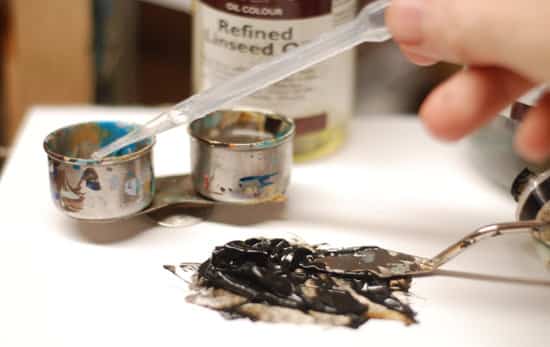
Paint consistency
When you are just beginning with oils, the handling of the paint can vary greatly depending on the consistency of the paint.
Oil paint (especially the titanium white) is often too thick and stiff to work with at this stage of the painting – straight from the tube.
To make the paint more fluid, I slightly dilute it with the medium shown above. I use a pipette to drop a few drops of the medium onto the paint mixture and mix it thoroughly with the palette knife. Using the palette knife for mixing your paints is a very useful technique.
The video below shows a quick tutorial on how I dilute the oil paint.
I often mix the colours on a separate, tear-off palette and then transfer the mixture to the clean glass/ perspex.
If you’re just beginning with oils you’ll notice how easily you can contaminate colours when using a full palette of colours, this can lead to muddy colours and frustrating painting.
This helps you to learn clean working methods. I am naturally more impatient so it is a discipline to spend the time mixing the colours as you just want to get painting but it will pay dividends.

Step 14 – Mixing our tonal colour strings
This next stage of the portrait is where we really get ‘painting’ as in, thicker, more opaque colours mixed together. If we look back at the last couple of weeks lessons you can see that we haven’t actually mixed any tones together yet.
We have simply been blocking in the basic tonal values, in what is sometimes called the ‘dead colouring stage’ this is because we are using a limited amount of oil in the mix, and more mineral spirits. As the mineral spirits evaporate the colour can appear flat, and ‘dead’ as it doesn’t have the lustre that the oil gives us.
Pro tip: When working with colour, this is also referred to as adding the ‘local colour’ of a subject. For example, a lemon would have a local colour of yellow.
So before we start the painting we are going to premix a range of 9 value tones.
White (1) is the lightest, black (9) is the darkest. This enables us to get a mid tone 5 and split the tones into lights, half tones, and darks. These are called tonal strings, you can read more about them on A beginners guide to tonal strings
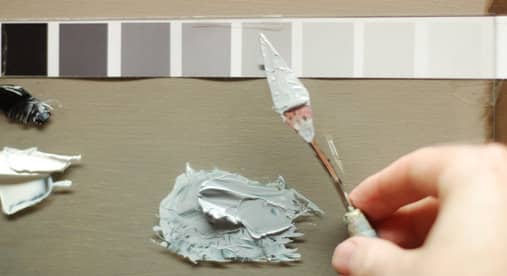
Using a value strip

Print out, or paint out, your own value strip.
When you are first starting, working from a print out it can be handy because the value strip will be the same tones as your reference photograph compared to the hues of the black and white paint if you were to paint your strip.
Just slide the value strip under the glass. This way when you are trying to match the tone you can test it by dabbing a swatch ontop of the tone underneath to determine how close you are.
The first tone I match is a number 5. It will take you a few attempts to get it spot on, this is normal.
Be aware that the black has a stronger tinting strength than the white so when I add it I’m just scraping a small amount with the palette knife.

I then match a light value 3
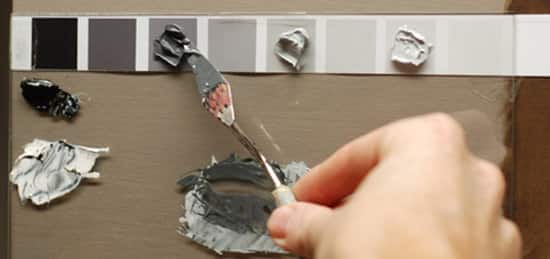
Then a value 7. With these 3 tones, you can create some great value studies (which are sometimes called ‘poster studies’) these allow to quickly practice and sketch out tonal compositions for future paintings.
It is also handy if you want to experiment working with a compressed value range.
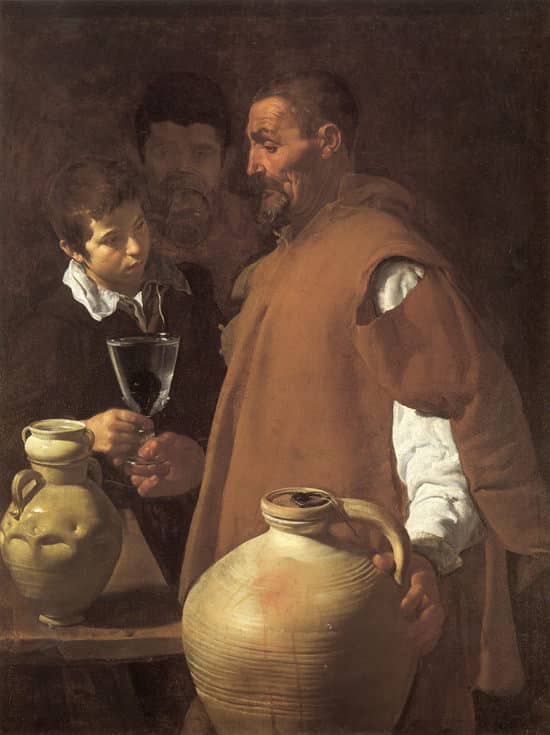
Waterseller of Seville –Diego Velazquez, 1619
If we look at Velasquez’s painting below we can see his use of the umber underpainting, and the range of tones used to direct the views gaze.
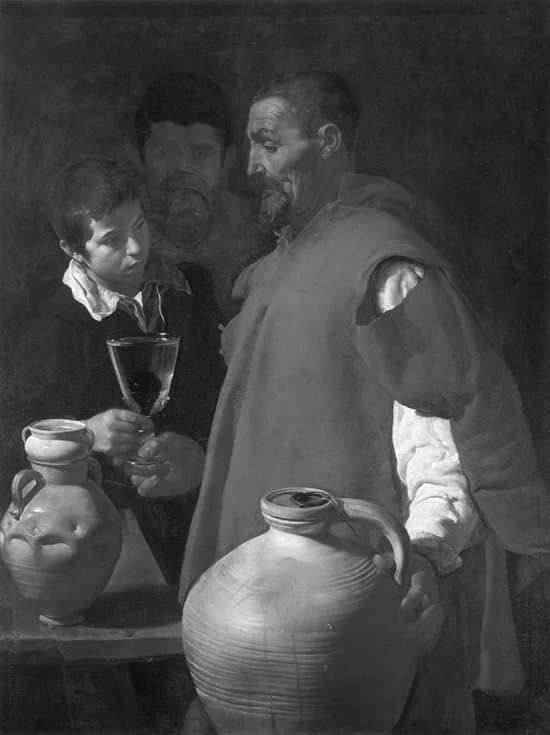
When we look at the painting in black and white it is even easier to see how the most focus on the painting has been placed on the subject with the broadest tonal range and the background figure has a very compressed tonal range.
9 value tones
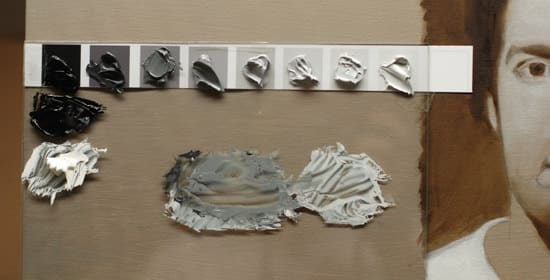
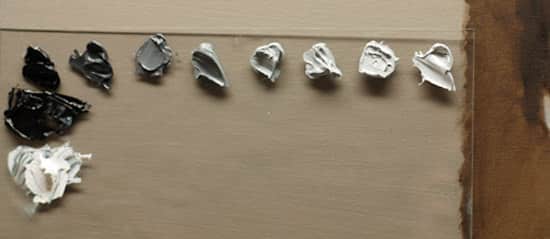
I then remove the value strip and we are ready to begin.
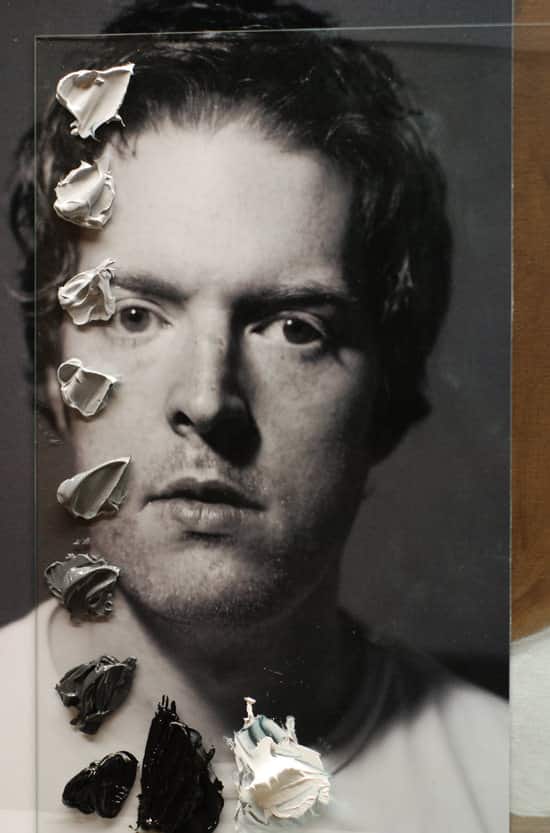
Due to my light source being above the subject the light drops off as we get further down the face. When you look at the colour strings you can start to see how there is a subtle shift in tone as we go down the painting. This is a key point to remember because when you take the paint swatches away it is harder to judge the light drop off, your mind just accepts it.
The light was set up so that it was stronger on the top half of the portrait, and the value drops away. You need to be aware of this drop off as you progress through the tones.
This can help in getting the fall of light right, and creating a logical progression throughout the painting.
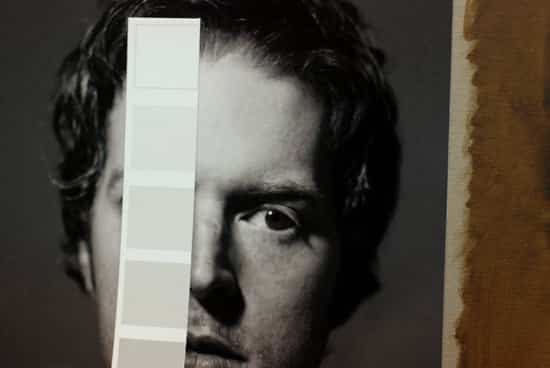
So what you can do now is remove the value strip from underneath the paint and hold it next to your reference photograph. Make sure you have trimmed the edge of the value strip so you don’t have any white on the edge. This will make it harder to judge tones.
Now shut one eye, this helps to flatten your vision and makes it easier to see tone. Then flick your eyes between the tone and the value strip and the tone on the reference photograph until you have a match.
Pro tip: If you are finding it hard to isolate the colour the use a hole-punch to punch a hole in each square, this way you can use them as a viewfinder.
Solid painting
“For purposes of study there is nothing better than simple, direct, solid painting. Painting with transparent colour, with a mixture of solid and transparent, glazing etc are all things that must be tried later on; but for some time confine yourself to direct, solid painting.” – Harold Speed
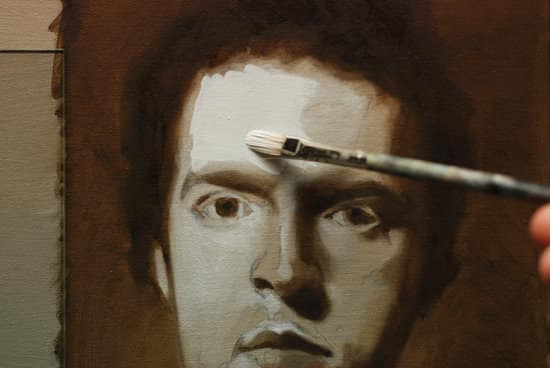
On my image I start with the lightest part on the forehead, it is about a value 2.
I dip just the edge of my brush (number# 4 Rosemary & co Ivory Filbert) into the medium.
I then pull the paint from the side of the mixture and coat the end of the brush. The mixture is thick enough to cover the underpainting, but still quite thin.
You are looking to cover the colour underneath with a solid tone but still have a fluid mixture. Getting the consistency right can be an art in itself, so don’t get discouraged!
We just want a small amount of paint, notice how I pull the paint from the edge of the pile.
You also don’t need much paint, just try to get the tip of the bristles coated, I work the brush back and forth in the paint so it has a coverage, yet doesn’t come up the bristles too far.
A beginners tendency is to overload your brush.

I then flick my eyes between the subject and my painting to judge the next tonal shift, I squeeze any excess paint into a piece of kitchen roll until the brush is dry,
I can then grab some of the next value down – value 3
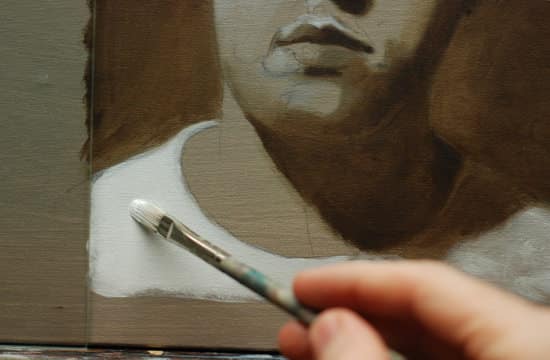
Just to help my eye with the portrait, I reinforce the white of the t-shirt with value 1.
This could have been put in first, there is no real hard and fast rule, I just scan the picture with my eyes to look for any values that are in the first 3 light range.
Adding the mid tones
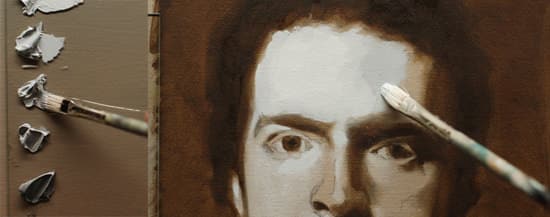
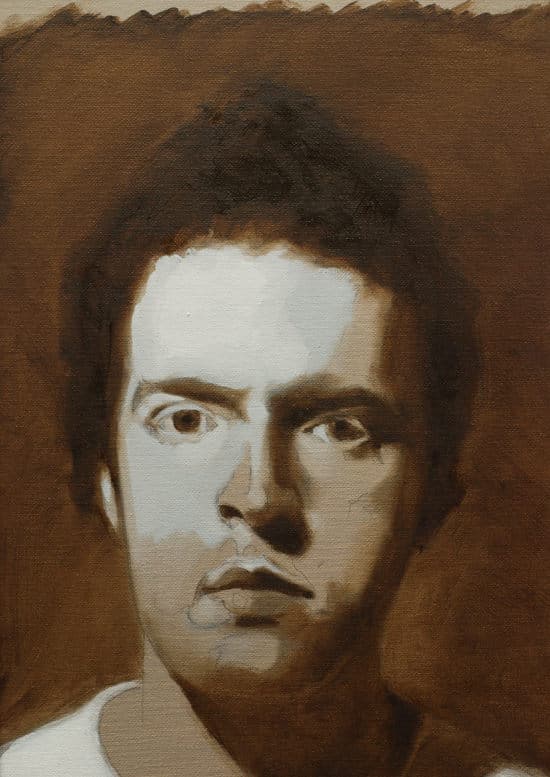
I then move on to the mid-tones, again with a clean brush (I might dip it into pure mineral spirits occasionally and scrub out the pigment into kitchen roll so I have a clean brush for the new tone.
I then make my way down the tones using 4, 5, 6. Notice how these are all still in the lights of the subject.
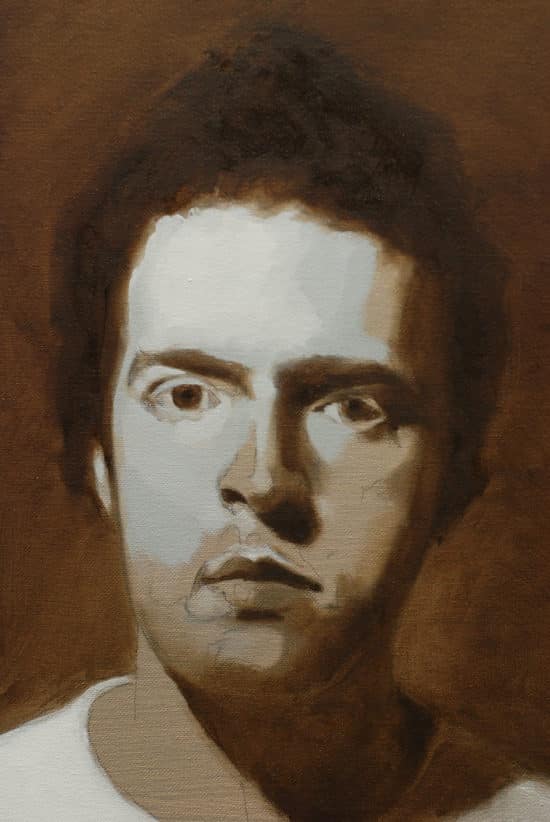
I haven’t blended any of the tones, I am just simply blocking them in with a flat tone.
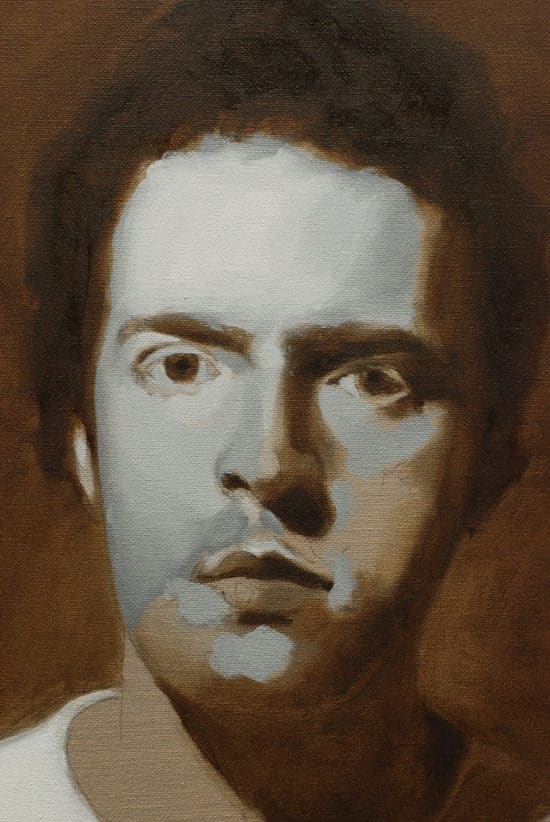
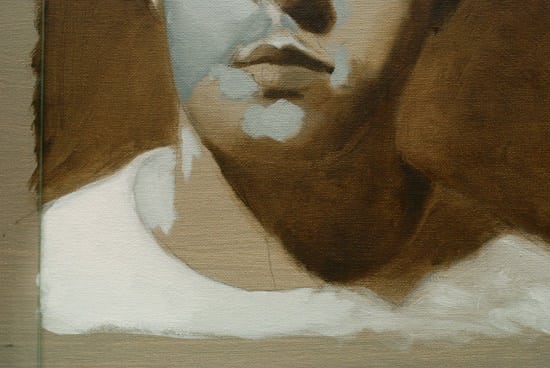
I then block in the tone on the neck, again this could have been done earlier but you’ll find the more tones you add, the easier they are to judge in comparison.
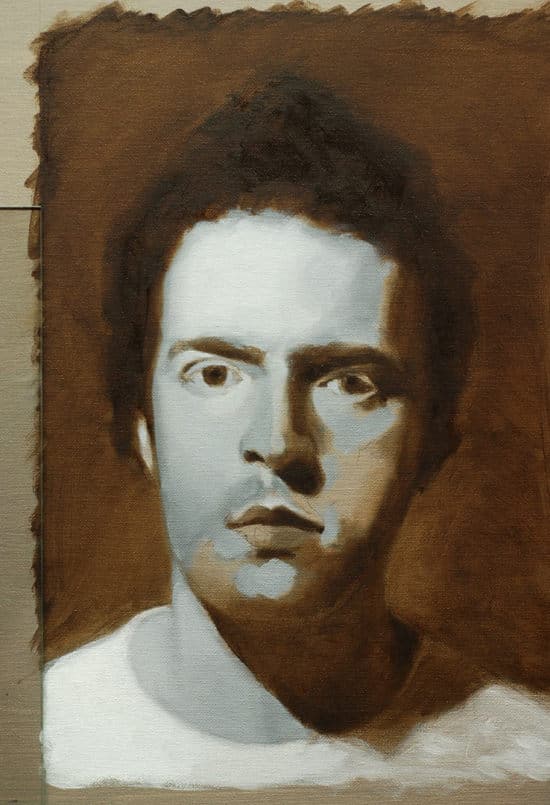
All of the lights are now added, this has all been painting with values 1 through to 6.
We are now going to add the darks, working through 7 to 9
Adding the darks
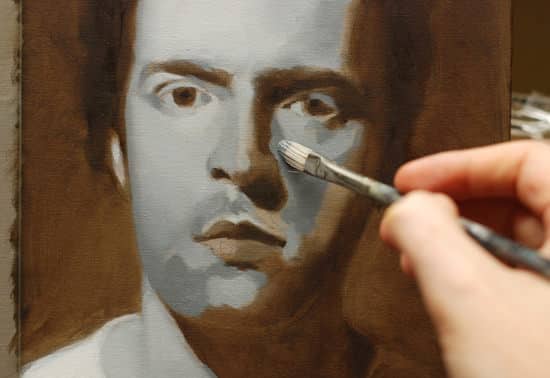
As the light starts to drop off, I add the darks into the shadow side of the face, notice how the tones have been dropping darker to the right and the bottom of the picture due to the light source being from the top left.
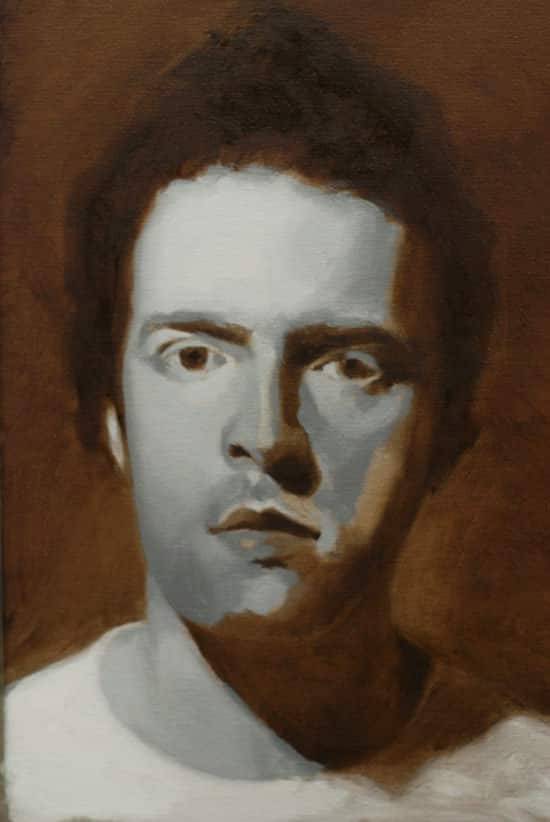

I continue adding a darker value 8 into the shadow under the chin. Notice how blue the paint appears next to the raw umber. The tones are still quite flat with limited blending, still just using the size 4 ivory filbert.

I now mix a value between the 8 & 9, you could go straight in with the 9, but I wanted to leave this for the final part of this stage.

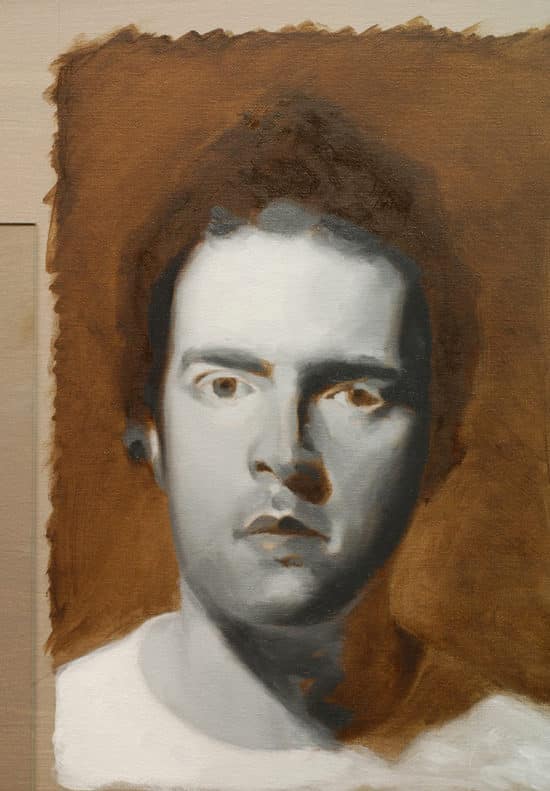
I then soften the edge slightly using the filbert.
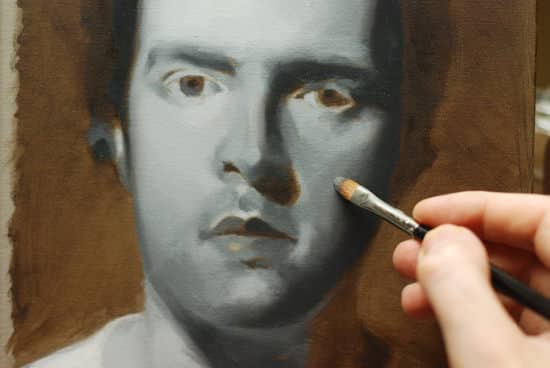
I swap to a sable filbert for blending the edges further, as I mentioned before, I often use the Ivory filbert for this, but sometimes, if the paint is pulling too much the sable can just give you that blend that you are after.
Because the underpainting is now dry I’m resting my little finger on the canvas, this way I can pivot, with a stronger support. For larger scale painting, or of the background is still damp I would use a mahl stick.

This is now with the value 9, the pure black mix we have made. When this first goes on it will feel too dark. It’s not.
I block in this black slightly thinner than the previous paint, I’m still concerned with creating a flat tonal value. Notice how I’ve left a slight edge between this darker tone and the edge of the face. This way when I soften the edge it won’t go too dark.
A tendency when you’re first starting is to add, then blend, add then blend, but it will work better if you keep the blending to a minimum.
This is easier said than done.
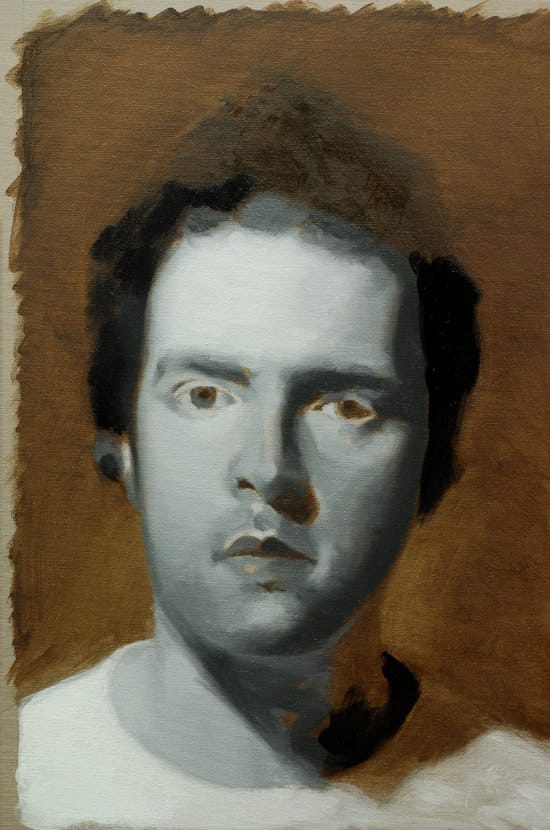
Notice how light the first shadow now looks in comparison to the black.
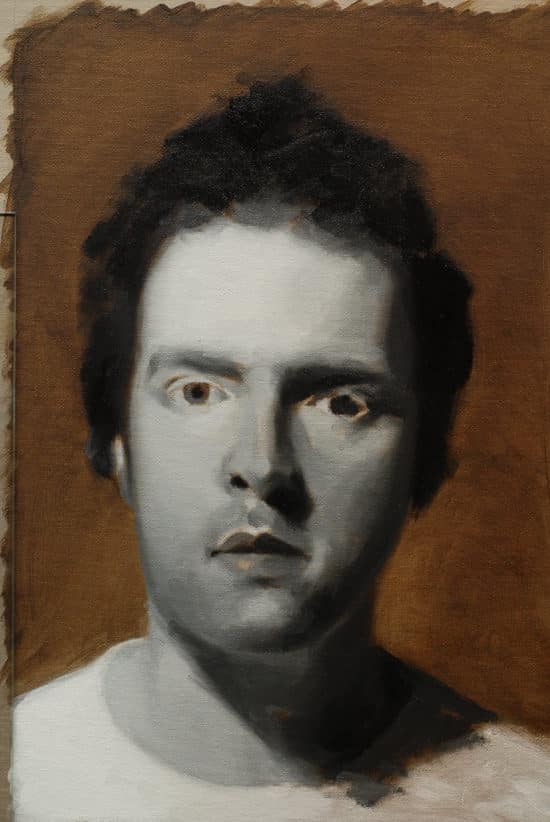
This stage of the painting I now have a full tonal range of opaque colour. I can now assess the reference image and flick my eyes between the two, looking for anything that looks ‘out’.
The Importance of edges
I now look to soften out most of the edges. As with the underpainting, it is easiest to keep the edges soft at this stage as they can easily grab a viewers attention. Sharp edges come forward, soft edges recede back.
Pro tip: If you are having trouble pulling the paint too much – swap to the larger size 10 filbert and gentle blush over the edge.
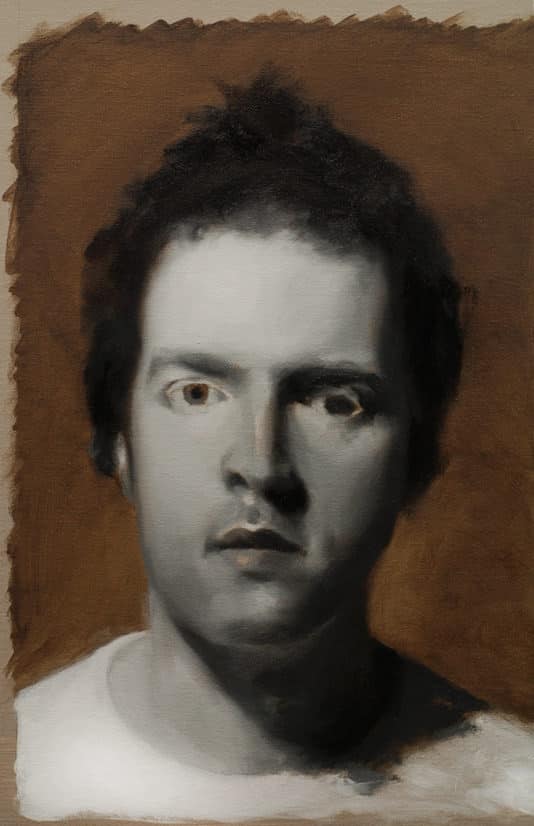
We’ve now finished the first stage of modelling the portrait. I haven’t worked on the features much, still just keeping the focus on the main areas of the form. The larger areas first, then we can add details in the next stage.
You might also like:
1. How to Paint a Portrait in Oil – Part 1
2. How to Paint a Portrait in Oil – Part 2
3. How to Paint a Portrait in Oil – Part 4

